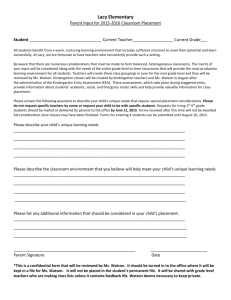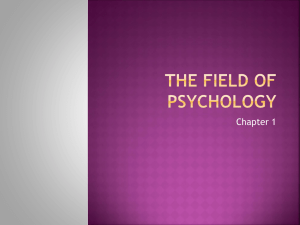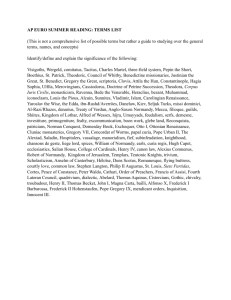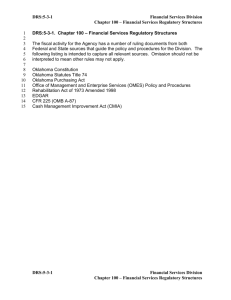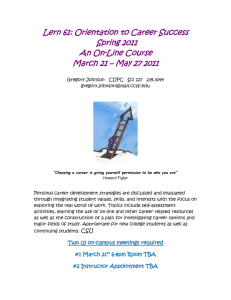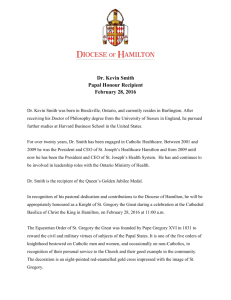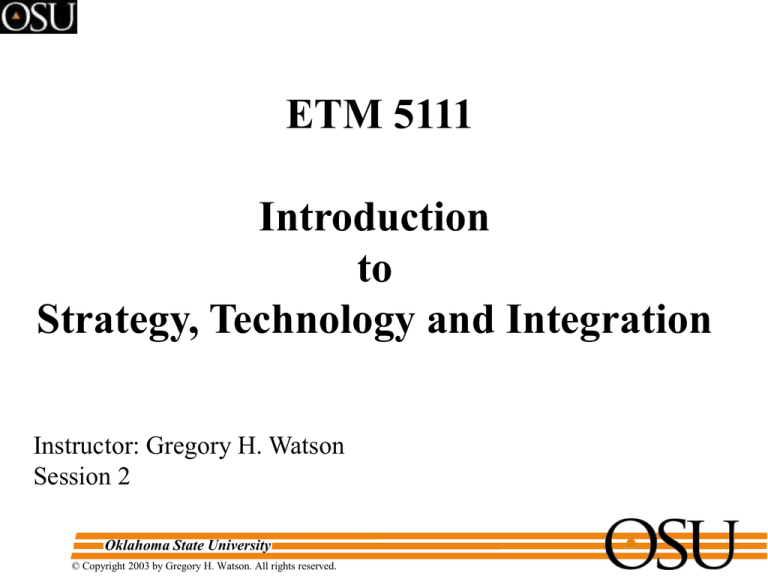
ETM 5111
Introduction
to
Strategy, Technology and Integration
Instructor: Gregory H. Watson
Session 2
Oklahoma State University
© Copyright 2003 by Gregory H. Watson. All rights reserved.
Session 2:
Developing a Foundation for Enduring Success
Instructor: Gregory H. Watson
Introduction to Strategy, Technology and Integration
ETM 5111 – Summer 2003
Oklahoma State University
© Copyright 2003 by Gregory H. Watson. All rights reserved.
Today’s topics:
Developing a Foundation for Enduring Success
• Part 1:
– Business Values & R&D Culture
• Part 2:
– Business Performance Measurement
– Balanced Scorecard & Customer Dashboard
• Part 3:
– R&D Portfolio Management & Budgeting
– Product Planning & Strategy Integration
Oklahoma State University
© Copyright 2003 by Gregory H. Watson. All rights reserved.
Business Values and R&D Culture
Instructor: Gregory H. Watson
Introduction to Strategy, Technology and Integration
ETM 5111 – Summer 2003
Session 2 – Part 1
Oklahoma State University
© Copyright 2003 by Gregory H. Watson. All rights reserved.
Values development cycle:
VALUES
Culture reinforces values.
CULTURE
Values define attitudes.
Connecting
People
ATTITUDES
Attitudes influence behavior.
Behavior creates culture.
BEHAVIOR
Management must be the role model of its desired behaviors
in order to create a pervasive culture that is self-perpetuating.
Oklahoma State University
© Copyright 2003 by Gregory H. Watson. All rights reserved.
Without values – conflict!
• What do you remember about the Union Carbide problem that
occurred in Bhopal, India?
• Did Union-Carbide have a values statement?
• Why did an ethical conflict erupt?
• What did they do about this problem (other than pay the fines)?
“Spoken values” must become “operational values” before
they can influence the way that an organization acts on a
daily basis.
Oklahoma State University
© Copyright 2003 by Gregory H. Watson. All rights reserved.
Types of values as a way of working:
• Moral values - the set of non-negotiable ethical values which define
an organization’s moral compass and are founded on principles of
integrity such as honesty, trust, and justice.
• Business values - values that have been selected and emphasized as
a means to describe and prescribe how people work together in this
organization. There are three primary applications of these values:
Decision values - what criteria are important when developing a
key organizational decision.
Action values - the characteristics that describe how this specific
organization wants it’s people to approach deployment of both
systemic and process change.
People values - how people should act toward one another and
respect the fragility of our humanity in the context of our working
relationships.
• Business values are subject to adaptation in different environments
or social contexts. Values should be regularly taught and reinforced
by personal “executive” example.
Oklahoma State University
© Copyright 2003 by Gregory H. Watson. All rights reserved.
How to measure values?
Management needs
a balanced approach
to measure all of its
unique performance
dimensions.
Customer
Employee
Learning
Stakeholder
Oklahoma State University
© Copyright 2003 by Gregory H. Watson. All rights reserved.
Personal exercise:
• Define your personal values – what motivates you to work? In
what order would you prioritize your values?
• Describe the values of your organization – are they consistent
with your personal values? How does your organization reinforce
these values?
• How are your organization’s values be measured? How do these
values and measures compare with those of your community?
• What is your organization’s ability to integrate change initiatives?
• How supportive is your management of innovative ideas?
Oklahoma State University
© Copyright 2003 by Gregory H. Watson. All rights reserved.
Discussion:
Priority
Describe what do
you most strongly
value? How will
we value this in our
divisions, sections
and committees?
Rank your values
in the order that
you perceive as
your priorities.
Oklahoma State University
© Copyright 2003 by Gregory H. Watson. All rights reserved.
Description of what is valued….
Some companies only value:
Make the numbers (MTN approach to managing):
When followed (at all costs), this approach can create:
• Ethical conflicts,
• Customer performance issues,
• Regulatory concerns, and
• Employee conflict.
Oklahoma State University
© Copyright 2003 by Gregory H. Watson. All rights reserved.
Basic business cultural values:
A generic model for business values:
Cultural values tend to fall into four basic categories:
Customer
Satisfaction
Continuous
Learning
Stakeholder
Value
Employee
Value
Oklahoma State University
© Copyright 2003 by Gregory H. Watson. All rights reserved.
Values sustain our way of working:
• Customer Satisfaction:
Keeps the focal point of the entire organization centered on its
customers.
• Employee Value:
Maintains the relevance and importance of our work to business
priorities.
• Stakeholder Value:
Concentrates on business objectives and uses common sense to
flexibly manage our choices as we are faced with new challenges
or contingencies that were not anticipated in our plans.
• Continuous Learning:
Sustains our performance improvement by discovering how to work
better based on facts and using data to make better decisions.
Oklahoma State University
© Copyright 2003 by Gregory H. Watson. All rights reserved.
Putting the customer first!
Customer
Satisfaction
Customer satisfaction is the result
that occurs when we concentrate
on knowing and understanding our
external customer’s needs (both as
they are explicitly understood and
as they exist in a latent state) and
applying our set of chosen values
to fulfill these needs and further
develop our business relationships.
In addressing fulfillment of both the
known and need of our customers
and satisfying them, we must align
our entire value system:
• Employee value
Shareholder value
• Continuous learning
•
Oklahoma State University
© Copyright 2003 by Gregory H. Watson. All rights reserved.
Principles of customer satisfaction:
We will reliably satisfy our customers when everyone:
•
•
•
•
•
Cultivates a sensitive attitude to customer needs,
concerns, problems and issues.
Designs products to suit our final customer in their
work environment, applying technology to provide
breakthroughs in improvement of their objectives.
Discovers new ways to create exceptional value in
the work or life of our targeted customers.
Flexibly adapts to a consistently changing set of our
customer’s desires, needs, requirements which will
together form their expectations.
Respects each customer and always has a caring
attitude in their routine relationships with them.
Oklahoma State University
© Copyright 2003 by Gregory H. Watson. All rights reserved.
Customer-focused behaviors:
The following behaviors will lead to customer satisfaction:
•
•
•
•
•
•
•
Acknowledge quickly all reported customer concerns.
Conduct all customer communications in a friendly,
polite, open, and yet frank manner.
Respond rapidly to totally resolve customer problems.
Seek rapid corrective actions for all problems.
Eliminate the root causes of all customer problems.
Prevent any further problem recurrence and its impact
on continued customer dissatisfaction.
Remember, each customer is our boss, we should not
be egotistical about our current position or our history
of past successes.
Oklahoma State University
© Copyright 2003 by Gregory H. Watson. All rights reserved.
Customer satisfaction competencies:
The following competencies enhance customer satisfaction:
•
•
•
•
•
•
•
•
•
•
Helping others
Managing complexity
Problem solving
Teamwork and cooperation
Relationship-building
Active listening
Persuasive capability
Personal credibility and reliability
Empathetic interpersonal understanding
Interpersonal problem solving skills
Oklahoma State University
© Copyright 2003 by Gregory H. Watson. All rights reserved.
Value employees to grow value!
•
Employee
Value
•
•
•
Oklahoma State University
© Copyright 2003 by Gregory H. Watson. All rights reserved.
People are the most renewable resource
of an organization and an organization is
only as strong as the joint capabilities of
its people.
Each person is worthy of respect since
we have chosen them to join our team for
the value that they will contribute to our
customers.
Each person’s job should provide them
with a genuine opportunity for personal
growth through their involvement and
contribution toward our common goals.
Respect for the individual means that we
should treat everyone as we would like to
be treated.
Employees value principles:
When an organization’s people have mutual respect for
one another, then everyone:
•
•
•
•
•
•
•
•
Contributes their best -- working together in trust.
Builds dependence upon each other.
Manages using facts to make decisions.
Acts to prevent process failures from affecting our
customers.
Uses common sense to manage daily activities.
Respects individual rights and dignity.
Supports and emphasizes diversity.
Develops mutual trust and cooperation.
Oklahoma State University
© Copyright 2003 by Gregory H. Watson. All rights reserved.
Employee value behaviors:
Behaviors that are important in order to demonstrate
employees are valued:
• Openly discuss business issues with associates.
• Recognize cultural differences and accept diversity as a
strength to permit us to serve a diverse customer base.
• Take individual needs into account, even when difficult, or
unpopular decisions must be made.
• Listen actively to objectively evaluate facts for making
decisions.
Make decisions collaboratively so that people affected by
a decision support its outcome.
• Formulate personal objectives and review them to ensure
that they remain valid.
Measure goals to assure objectivity in evaluating the
contributions of individuals.
• Align each individual’s objectives with a common set of
business objectives to achieve shared vision.
•
•
Oklahoma State University
© Copyright 2003 by Gregory H. Watson. All rights reserved.
Employee value competencies:
What competencies are required to build self-esteem
within employees?
•
•
•
•
•
•
•
•
Interpersonal communication and active listening
Self-confidence
Relationship-building
Flexibility
Teamwork and co-operation
Helping others
Self-control
Dealing with failure
Oklahoma State University
© Copyright 2003 by Gregory H. Watson. All rights reserved.
The measures of our results:
We do every task expertly, so that:
Stakeholder
Value
• Our customers recognize us as a product
•
•
•
•
•
Oklahoma State University
© Copyright 2003 by Gregory H. Watson. All rights reserved.
quality leader.
Our suppliers rate us their best partner.
Trade awards demonstrate that we
consistently develop the most innovative
products in our industry.
Our shareholders are pleased with their
investment.
We are admired for our management.
Our employees think that this is the best
place to work.
Principles of stakeholder value:
In order for people to have the “will to fight in order to
win,” they are entitled to:
• Shared vision and goals.
• Measurable performance indicators and agreed
•
•
•
•
•
upon targets.
Clear understanding of roles, responsibilities
and decision rights.
Adequate resources to accomplish their
activities.
Responsibility for process ownership and
improvement.
Appreciation for efforts and recognition of
accomplishments.
Feedback and coaching on their performance.
Oklahoma State University
© Copyright 2003 by Gregory H. Watson. All rights reserved.
Stakeholder value behaviors:
In order to consistently achieve success, we must:
•
•
•
•
•
•
•
Share information and responsibility so that everyone
knows what is expected.
Seek profitable growth through productivity and
market penetration.
Seek to design and manage the most cost-effective
business and work processes in the industry.
Resolve problems and improve processes.
Keep budgets on target and deliver outputs ahead of
targets.
Seek continuous improvement and opportunities to
make breakthroughs.
Never promise more than can be delivered.
Oklahoma State University
© Copyright 2003 by Gregory H. Watson. All rights reserved.
Stakeholder value competencies:
What competencies are required to consistently deliver
exceptional value to the organization’s stakeholders and
to excel at achievement?
•
•
•
•
•
•
•
•
•
•
•
Goal-oriented thinking
Organizational commitment
Tenacity and constancy of purpose
Initiative and “will to excel”
Organizational ability
Concern for order and performance
Ability to manage complexity
Flexibility in thinking style
Innovative approach to business issues
Self-confidence in their personal competence
Business knowledge and intuition
Oklahoma State University
© Copyright 2003 by Gregory H. Watson. All rights reserved.
Knowledge is learned!
Continuous
Learning
• We must accept our achievements with
humility and not believe that we are so
good there is no need to learn from
others.
• We must resist the “Not Invented Here”
or NIH syndrome when we are looking
into areas of improvement.
• We must benchmark our performance
against “best practice” organizations to
increase our own core competence.
• We must creatively imitate the best
practices of leading companies.
• We need to renew our personal skills to
prepare for an uncertain future.
Oklahoma State University
© Copyright 2003 by Gregory H. Watson. All rights reserved.
Principles of continuous learning:
What are the principles of continuous learning found in
a knowledge-oriented company?
•
•
•
•
•
Innovativeness and the courage to depart from
known territory and support for professional and
personal growth.
No place for complacency – learn to experiment
and encourage the “will” to take risks.
Ability to accept failure when not achieving stretch
goals, but not seeking failure when we can find a
better route for improved performance -- especially,
not repeating past mistakes.
Acceptance of change and tolerance for a work
environment characterized by chaos or uncertainty.
Maintain a humble attitude and an open mind.
Oklahoma State University
© Copyright 2003 by Gregory H. Watson. All rights reserved.
Behaviors for continuous learning:
An individual who is personally committed to continuous
learning will:
•
•
•
•
•
Blend development styles to encourage the best
application of methods to develop organizational
learning: formal training, on-the-job experience,
coaching, mentoring or job rotation.
Use their personal development plan as a means to
align with organizational needs for development of
skills that lead to core competence.
Perseveres to continue exploring new knowledge in
the face of doubt.
Serves as a coach or mentor to others in areas of
personal expertise.
Use the opportunity for lateral job rotations to expand
their personal experience and gain new knowledge.
Oklahoma State University
© Copyright 2003 by Gregory H. Watson. All rights reserved.
Competence for continuous learning:
What specific competencies are required to become a
knowledge “company” and practice continuous learning?
•
•
•
•
•
•
•
Curiosity and initiative to seek new knowledge.
Expertise in helping others, coaching and mentoring.
Active listening and analytical thinking.
Ability to accept potential failure and courage to deal
with an environment of risk and uncertainty.
Organizational awareness and wide range of interests.
Willingness to share knowledge within and across the
organizational boundaries.
Willingness to learn from external organizations and
the ability to use analogy to compare performance of
different business models.
Oklahoma State University
© Copyright 2003 by Gregory H. Watson. All rights reserved.
Putting it all together:
Value
System
A common way of working is delivered by these four cultural values:
•
•
•
•
•
•
•
•
•
The winning spirit – striving for the desired results
Common vision and clear personal priorities
High morale and uncompromising business ethics
Teamwork and collaboration across functional boundaries
Communication, feedback, and respect for diverse opinions
Appreciation for the contributions of others
Empowered decision making using facts over opinions
Personal responsibility for implementation of actions
Recognition and reward based on measured performance
Oklahoma State University
© Copyright 2003 by Gregory H. Watson. All rights reserved.
Example of a company value system – Compaq:
Teamwork – everyone works together for the common good.
Customer first – put the customer first in everything that we do.
Consensus decision-making – make decisions based on the
input of all involved people and once a decision is made, then
follow through as a team.
Manage using facts – make objective decisions using analysis
and facts to expose alternatives and define direction.
Do what makes sense – always apply common sense to validate
actions and assure that we do what is right.
Continuous improvement – continuously improve our processes
for working and the results that we achieve.
Rod Canion, Compaq Founder: “If I managed in any other way
then the organization would think that we weren’t serious about
these values and it would undo all the hard work we put in place
to define our system for working.”
Oklahoma State University
© Copyright 2003 by Gregory H. Watson. All rights reserved.
What’s the objective of technology management?
• The principal function of a technology organization is to assure the longrange technological competitive advantage of a company. In order to
meet this function a technology organization must be able to conduct
effectively several critical business processes:
– Strategic planning
– Competitive analysis
– Technology assessment
– Project management
– Research & technology development
– Intellectual property application
– Technology transfer to product lines
• A technology organization contributes future business value through it’s
contribution toward future competitive advantage that is fully supportive
of the organization’s strategic intent.
• Proposed Mission: To develop business intellectual capital that permits
an organization to both gain and sustain a competitive advantage in its
chosen fields.
Oklahoma State University
© Copyright 2003 by Gregory H. Watson. All rights reserved.
How does this relate to business?
• A technology organization contributes value to a business in two
significant ways:
– Through direct contributions to the company’s product lines.
– Through assurance of technology leadership in the market place.
• Technology outcomes must provide both renewal for the current
product portfolio and also extensions of the product portfolio by
providing innovative product concepts (first commercial use).
• In order to meet the long-range requirement for innovation any hightechnology company must create a synergy in its strategy for
investment in technology between its internal and external
opportunities including both development and licensing options.
• Excellence in this vision would provide a seamless flow of ideas from
the level of physics into product concepts into product line features
and deliverable products.
• In order to optimize a high technology business, an organization
must seek synergy by combining it’s strategic plans for advanced
development, business development, and research.
Oklahoma State University
© Copyright 2003 by Gregory H. Watson. All rights reserved.
How does technology management add value?
• Considering the value contribution:
– First, develop a strategy to achieve technology differentiation.
– Second, assess where competitors have technology advantages.
– Third, block competitor’s technology advances using patents.
– Fourth, create revenue opportunity through intellectual capital.
– Fifth, create new concepts or features for inclusion in products.
– Finally, develop new customer applications for technology.
• The output consists of two product contributions:
– Product features: capability that may be directly added to current or
future products in order to enhance their desirability to customers. The
measure of success for this output is the “concept to commodity”
conversion rate.
– Intellectual capital: capability that may be sold, licensed or bartered to
improve the company’s competitive position. The measure of success
for this output is the royalty revenue generated by this property plus the
cost avoidance in royalty investment through bartering arrangements.
Compete through innovative products and production processes!
Oklahoma State University
© Copyright 2003 by Gregory H. Watson. All rights reserved.
What would be “poor quality” in development?
• Of course, the objective is to produce “quality outcomes.” But in order
to apply this, we must know what poor quality looks like.
• To determine what the meaning of “poor quality” consider the two types
of defects that could exist in a research organization.
– The first type of defect comes from violation of the laws of nature
(physics), mathematics (statistics), errors in software, and problems
in communication that cause confusion (special cause defects).
– The second type of defect comes from the wrong investment of
time in the pursuit of a technology that has no viable commercial
application (this is an opportunity cost type of defect -- the time of
researchers could have been better invested in other technology
pursuits with a better payoff) (common cause defects).
• Poor quality research results in embarrassment from visible errors in
published research or lack of acceptance by customers (either by the
product line manager or the consumer).
• Good quality research results in sustained competitive advantage and
an enhanced reputation as a “technology leader.”
Oklahoma State University
© Copyright 2003 by Gregory H. Watson. All rights reserved.
Type I quality defects:
• This type of defect is the direct result of a failure in the system:*
– Technology failure: the research product fails to deliver the
advertised performance or product capability.
– Market failure: the research product does not have economic utility to
it’s targeted customers or it’s application uniqueness is not accepted.
– Procedural failure: the research product possesses a fundamental
flaw in it’s underlying technology (physics, mathematics or software).
– Opportunity failure: the delivery of the research product is not within
the market opportunity window to capitalize upon the development.
– Implementation failure: the production technology is not sufficiently
mature to deliver the research product in commercial quantities.
• For this defect, a quality goal of “zero defects” in research is achievable,
but achievement of this goal will not necessarily result in sustained
(beyond a product life cycle) competitive advantage for the company!
Note:
People may be held accountable for these errors because they are all
“special cause” in nature. This means that their root cause(s) may be
determined by the engineering team and then prevented in future projects.
Oklahoma State University
© Copyright 2003 by Gregory H. Watson. All rights reserved.
Type II quality defects:
• A “Type II Defect” is the opportunity cost of investing resources in the
pursuit of a low-payoff or no-payoff project, compared to other uses of
these resources for building competitive advantage.
• This type of defect is a direct result of technology focused on the wrong
subject and is precipitated by a failure of the management system -- a
common cause failure -- and management should be held accountable!
• Common cause defects are not preventable by research teams but are
avoidable by management through more effective long-range planning.
• Achieving the goal of “zero defects” in this defect category is probably
neither achievable nor desirable. Why? The future is uncertain and
there is no sure knowledge of which technologies will have the highest
potential value. Decisions about where to invest in this uncertainty
must be probabilities and therefore some degree of uncertainty (failure)
must be accepted in the results. If a technology organization does not
fail sometimes, then it may not push the limits of it’s technology! The
goal that should be set for this measure should encourage innovation –
for instance: “achieving an 80% implementation rate” for outputs (both
features and intellectual capital).
Oklahoma State University
© Copyright 2003 by Gregory H. Watson. All rights reserved.
Values development cycle:
VALUES
Culture reinforces values.
CULTURE
Values define attitudes.
Connecting
People
ATTITUDES
Attitudes influence behavior.
Behavior creates culture.
BEHAVIOR
Management must be the role model of its desired behaviors
in order to create a pervasive culture that is self-perpetuating.
Oklahoma State University
© Copyright 2003 by Gregory H. Watson. All rights reserved.
Personal reflection:
Given the description of values, general categories
of business values, and the business description for
a technology enterprise, what would you choose for
a set of values for a technology organization (but,
choose no more than seven business values):
1.
2.
3.
4.
5.
6.
7.
________________________
________________________
________________________
________________________
________________________
________________________
________________________
Oklahoma State University
© Copyright 2003 by Gregory H. Watson. All rights reserved.
ETM – 5111:
BREAK
Instructor: Gregory H. Watson
Summer 2003
Session 2 – End of Part 1
Oklahoma State University
© Copyright 2003 by Gregory H. Watson. All rights reserved.


